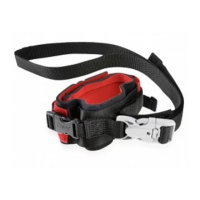Posey
®
Twice-As-Tough
®
Cuffs 2700Q, 2700QL
Application Instructions for Wrist and Ankle
© Posey Products, LLC. All rights reserved.
TIDI Products, LLC • 570 Enterprise Drive, Neenah, WI 54956 USA
Phone: 1.800.447.6739 • International: +1.920.751.4036 • www.tidiproducts.com
ADDITIONAL SAFETY AND LAUNDERING INSTRUCTIONS ON OTHER SIDE.
DESCRIPTION OF PRODUCT: Padded limb restraints with double-security closure.
For bed and stretcher use only.
INTENDED USE:
•
Patients assessed to be at risk of disrupting life-saving treatments (e.g., chronic tube
pulling) or in danger of injury to themselves or to others.
•
Follow your hospital’s restraint policies and procedures which are in compliance
with USA CMS guidelines and state laws, or other governing agencies outside the
USA.
CONTRAINDICATIONS:
Do not use this device with someone who has continued highly aggressive or
combative behavior, self-destructive behavior, or deemed to be an immediate risk to
others or to self. Clinicians may need to use additional interventions in conjunction
with restraints.
APPLICATION INSTRUCTIONS: (Repeat steps 1 and 2 for each side):
The order of either application of the straps to the bed OR
applying the cu to the patient is to be determined by the
clinician/physician depending on the situation.
1. Wrap the connecting strap at least once around the frame
that moves with the patient, out of the reach of the patient (Fig.
1). (Do not attach to the side rail or head/footboard). If buckle
does not t an opening, use the alternate method by looping
the webbing through the frame opening, inserting the buckle
through the loop, and securing the male buckle to the female
buckle to secure (Fig. 2). Close the gray quick-release buckle by
sliding the male end into the female end (Fig. 3). The gray quick-
release buckle will only release when applying pressure on all
three buttons in Fig 3.
2. Once the buckle is in place and the strap is secured to the
frame, pull on the excess strap end to adjust to the desired
length between the cu and the attachment point. To limit
unwanted adjustment, tie an overhand knot with the excess
strap directly below the quick-release buckle. Secure the
remaining strap end(s) out of the reach of the patient.
APPLYING THE CUFFS: (Repeat steps 1 – 4 for each side):
1. Wrap the neoprene piece around the wrist or ankle so the
buckle and connecting strap is on the ulnar side of the wrist or
lateral malleolus of the ankle. Attach the black hook-and-loop
pieces together and pull back the black pull tab on the blue or
red fuzzy piece, followed by attaching the blue or red hook-and-loop pieces. The
fuzzy piece should be sandwiched between the two pieces of hook (Fig. 5). Be sure to
overlap at least one inch (3 cm).
2. Press the hook-and-loop closure together rmly and make sure it adheres securely.
Slide one nger (at) between the cu and the inside of the patient’s wrist or ankle to
ensure proper t.
3. Close the quick-release buckle on the cu. Insert one nger (at) under the buckle
and pull the strap snug, but not so tight as to restrict circulation.
4. Release the quick-release buckle, twist buckle 180° (Fig. 5), and reconnect. Listen for
a “snapping” sound.
ADJUSTING STRAP LENGTH:
Adjust the connecting strap(s) length from the frame to allow desired freedom of
movement without compromising patient or caregiver safety. Ensure the remaining
strap end(s) are secured and out of the reach of the patient.
TO LIMIT LOWER LIMB RANGE OF MOTION (Fig. 6):
The clinician applying the strap’s criss-cross
application method can determine which is
applied rst (cu or strap) and which end of
the restraint is criss-crossed.
1. Attach the cu that is secured to the
bottom right side of the bed to the le ankle.
2. Criss-cross the straps and attach the cu
secured to the bottom le side of the bed to
the right ankle.
3. Adjust connecting straps as necessary.
PRECAUTIONS:
•
A clinical assessment and decision are required when used with monitoring lines or
if patient has a wound or dislocated/fractured limb.
•
Check the patient regularly to ensure that circulation is not impaired. Serious injury
may occur if the cus restricts circulation when the limb holder is applied.
•
Before each use, check cus and straps for cracks, tears, and/or excessive wear or
stretch, broken buckles or locks, and/or that hook-and-loop adheres securely as
these may allow patient to remove cu. Discard if device is damaged or if unable to
lock.
•
WARNING: Additional or dierent body or limb restraints may be needed
(visit tidiproducts.com):
–
If the patient pulls violently against the bed straps.
–
To reduce the risk of the patient getting access to the line/wound/tube site.
–
To prevent the patient from ailing or bucking up and down and causing self-
injury.
BED SAFETY:
Refer to the Food and Drug Administration (FDA), or other governing agencies
outside the USA, for the most recent Hospital Bed Safety Guidelines and the bed
manufacturer’s instructions for use.
Rx ONLY
2700Q/
2700QL
POSEY TWICE-AS-TOUGH CUFFS:
2700Q
3 Point Quick-Release, Single Strap Cu, Regular/Blue
2700QL
3 Point Quick-Release, Single Strap Cu, Large/Red
May be patented: see www.tidiproducts.com/virtual-patent-marking
I9301 REV D 2022-09-30
Fig. 1
Fig. 3
Fig. 4
Fig. 5
Fig. 6

